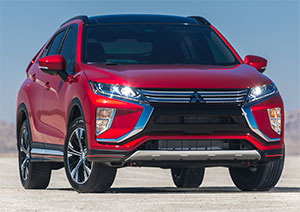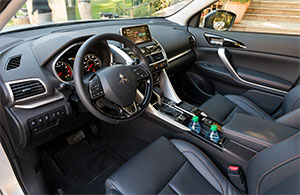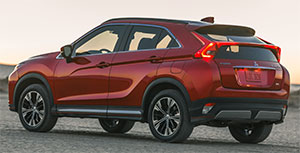2018 Mitsubishi Eclipse Cross
It was the best of times; it was the worst of times. Best, when we heard the rumor that Mitsubishi was bringing back the eclipse; worst, when we found out that wasn’t quite the case, as they’d be using that sporty name on yet another compact crossover. Let’s see if driving the new eclipse cross will put an end to our Dickensian dilemma.
Just when we weren’t too sure about what exactly was going on at Mitsubishi, now that they have aligned themselves with Nissan and Renault, we get word of this new compact crossover, the 2018 Eclipse Cross. Size-wise, it slides in between the Outlander and Outlander Sport in their lineup.
Much like the Honda CRV it would love to steal some sales from, the Eclipse Cross is tiny-turbo-powered with a 1.5-liter I4 rated at 152-horsepower, well short of the CR-Vs 190. There’s more torque, however; 184 lb-ft., compared to Honda’s 179.
Like the CR-V, the Eclipse Cross is CVT tranny only, and base ES trim is the only one available with front-wheel-drive. All other trims come with Mitsubishi’s Super All-Wheel Control all-wheel-drive.
 Those kind of power numbers didn’t exactly peak our anticipation for test track results. Still, the Eclipse Cross doesn’t feel underpowered by any means. It’s a little lazy at launch, but then graceful amounts of power begin pouring on, ushering you to 60 in a respectable 8.6-seconds.
Those kind of power numbers didn’t exactly peak our anticipation for test track results. Still, the Eclipse Cross doesn’t feel underpowered by any means. It’s a little lazy at launch, but then graceful amounts of power begin pouring on, ushering you to 60 in a respectable 8.6-seconds.
The CVT has simulated shifts that help things sound a little less frantic working your way down the track. That all comes to an end in 16.7-seconds at 79 miles-per-hour.
Mitsubishi had to expect some backlash, choosing to resurrect the Eclipse sport coupe’s name on a ute; so they made an earnest attempt to make corner handling worthy of the name.
But a lot of the agility comes from the all-wheel-drive system, which uses selective braking to minimize understeer. Otherwise, we’d call it firmly average; betrayed by safe and slow steering and a fair amount of body roll.
The Eclipse Cross does have all of the features you expect in the modern day compact crossover. Meaning a color multi-information display, steering wheel controls, naturally a backup camera, plus automatic climate; they’re all standard.
Our mid-level SE was outfitted quite nicely, similar to many brand’s top trim levels; and adds a host of comfort and convenience features like heated seats, push button start, and Mitsubishi Connect.
 Unexpected features for this class like head-up display and multi-view camera are also available. Our SE also added advanced safety features like Blind Spot Warning and Rear Cross Traffic alert.
Unexpected features for this class like head-up display and multi-view camera are also available. Our SE also added advanced safety features like Blind Spot Warning and Rear Cross Traffic alert.
The 7-inch infotainment screen shoots out of the dash, and is controlled by a square touchpad controller on the console. There’s a definite learning curve to figure it out, and even once you do, it can be frustrating.
The Eclipse Cross launches a new Mitsubishi Connect subscription service that, in addition to the usual safety notifications, gives you remote access to your car with a cell phone app; allowing you to unlock the doors, change vehicle settings, and even set parental controls.
Seats are sufficiently comfortable, and the general pleasantness of the interior has you wanting to spend plenty of time in the cabin.
The exterior is among its best features; being rather dramatic looking for this usually appliance-like segment.
The front bares a strong resemblance to the Outlander family, and in profile the appearance favors a wedge, but yet a bit more coupish and sporty than most compact crossover rivals.
 The rear is tall, with a split-glass hatch that brings to mind the Pontiac Aztec and the original Honda Insight. While you do see more outside, the split is quite distracting through the rear view mirror.
The rear is tall, with a split-glass hatch that brings to mind the Pontiac Aztec and the original Honda Insight. While you do see more outside, the split is quite distracting through the rear view mirror.
Under the hatch, is a good 22.6 cubic-ft. of cargo space; expanding to 48.9 cubic-ft. with rear seats folded.
All-wheel-drive Eclipse Cross’ have Government Fuel Economy Ratings of 25-City, 26-Highway, and 25-Combined, which we matched almost perfectly with an average of 24.9 miles-per-gallon. Earning an average Energy Impact Score, with the use of 13.2-barrels of oil yearly while emitting 5.7-tons of CO2.
The front-drive Eclipse Cross starts at $24,290, all other trims come with all-wheel-drive and top out with the SEL Touring for $31,390.
While the brand has been on a roller coaster ride here in the U.S., becoming the junior member of the Renault-Nissan-Mitsubishi Alliance has added tremendous stability. And, given that Mitsubishi has a global history of building rugged, dependable, SUVs, we think 2018 Eclipse Cross has a real chance to succeed.
True, by bringing back the Eclipse name, Mitsubishi is clearly aiming to cash in on the Eclipse Coupe’s reputation as a stylish, compact performer that delivers a lot of bang for the buck. We can see many of those same words applying to the Eclipse Cross. So, it might just be exactly what Mitsubishi needs to stay relevant, as they continue to rebuild the brand here and around the world.
Specifications
- Horsepower: 152
- Torque: 184 lb-ft.
- 0-60 mph: 8.6 seconds
- 1/4 mile: 16.7 seconds @79 mph
- EPA: 25 mpg city / 26 mpg highway
- Energy Impact: 13.2 barrels of oil/yr
- CO2 Emissions: 5.7 tons/yr
2024 Toyota Land Cruiser
Toyota’s Go Anywhere Globetrotter Returns To U.S.
Every once in a while, we all need a reset. A time to get back to basics and prioritize the things that really matter. Well, for the Toyota Land Cruiser that time is now. So, let’s find out if that means bigger and better things for Toyota’s iconic off-roader.
The Toyota Land Cruiser’s status among the global off-road community is legendary, and it’s hard to imagine there’s any corner of the earth where a Land Cruiser hasn’t kicked up a little dust or mud. Well, 2024 sees the return of the Land Cruiser to the U.S. market after a 3-year hiatus, getting a major reset for the journey.
The reset comes mostly by no longer being based on the large three-row “300-series” chassis, but a new version of the smaller “200-series,” now known as the J250. As with the latest Tacoma, it uses the Tundra pickup’s full-size steel frame.
While the main Land Cruiser model, which goes by simply Land Cruiser, is packed full of luxury and convenience features, there is also a stripped-down model known as the 1958, honoring the first year the Land Cruiser made landfall here in North America. And it is that 1958 we have here, and we were glad to see it, as it also celebrates the original’s back-to-basics approach as a blank canvas for you to personalize as you tackle more and more adventures.
Not that it’s fully stripped down, as 8-inch touchscreen infotainment, a 7-inch full-color multi-information display, and automatic climate control are still standard. Plus, some seriously durable materials, and great heated cloth front seats that throw off some get serious 1990s Tacoma vibes.
But outside, there’s a definite lack of flashy trim and basic looking 18-inch wheels with Yokohama Geolander all-season tires; plus, big chunky bumpers and tilt-up back glass, which is a rarity that we appreciate. Though there is a little too much plastic in places that are sure to see some abuse if you do any significant off-roading.
It even feels a little rough around the edges, but for us it just adds to the rugged old-school utility vibe in a good way.
We did just that, both here in the Mid-Atlantic as well as in the California desert; and while there are some tech-forward driving aids, the actual hardware is in most cases plenty to get things done. That includes standard full-time dual-range four-wheel-drive, locking center and rear diffs, and 8.7-inches of ground clearance. A front stabilizer bar disconnect is also available to allow for increased articulation.
Who needs a V6 or even a V8 when you’ve got Toyota’s i-FORCE MAX setup at your disposal with 326 horsepower and 465 lb-ft of torque coming from a 2.4-liter turbo-four with an electric motor sandwiched between the engine and its eight-speed automatic transmission. Low speed torque delivery is impressive. It even feels a little rough around the edges, which may be a turn off to some, but for us it just adds to the rugged old-school utility vibe in a good way.
And it certainly feels quicker than an off roader needs to be, with an instant torque dump as soon as we eased on the throttle at our Mason Dixon test track; helping us get to 60 in 8.1 seconds and through the quarter-mile in 16.3 seconds at 86 mph. Considering the Land Cruiser’s terrain conquering mission, it behaved quite well in our handling course; it was plenty responsive to inputs, with less body roll than we expected and plenty of grip from the tires. The steering was light and quick but as expected didn’t provide much feel. Other than significant nosedive, braking performance was exceptional. Only 107-feet to panic stop us from 60 mph.
With the shift to the smaller size, there’s no more third row available, and cargo capacity now comes in at 46.2 cubic-feet with a max of a still healthy 82.1. Now, the best part of the Land Cruiser’s return is the entry price of $57,445. That’s about 30-grand less than what the last Land Cruiser went for back in 2021.
Whether it’s over the top fashion trends, mullets, or zombies; just when you think they’re dead, they come roaring back to life. Of course, we’re much happier to see the resurrection of this 2024 Toyota Land Cruiser than any of those things. Toyota is one brand that still recognizes the value of full-framed rugged rigs and has also acknowledged that sometimes less really is more. The Godfather of Toyota off-roading is back and better than ever.







